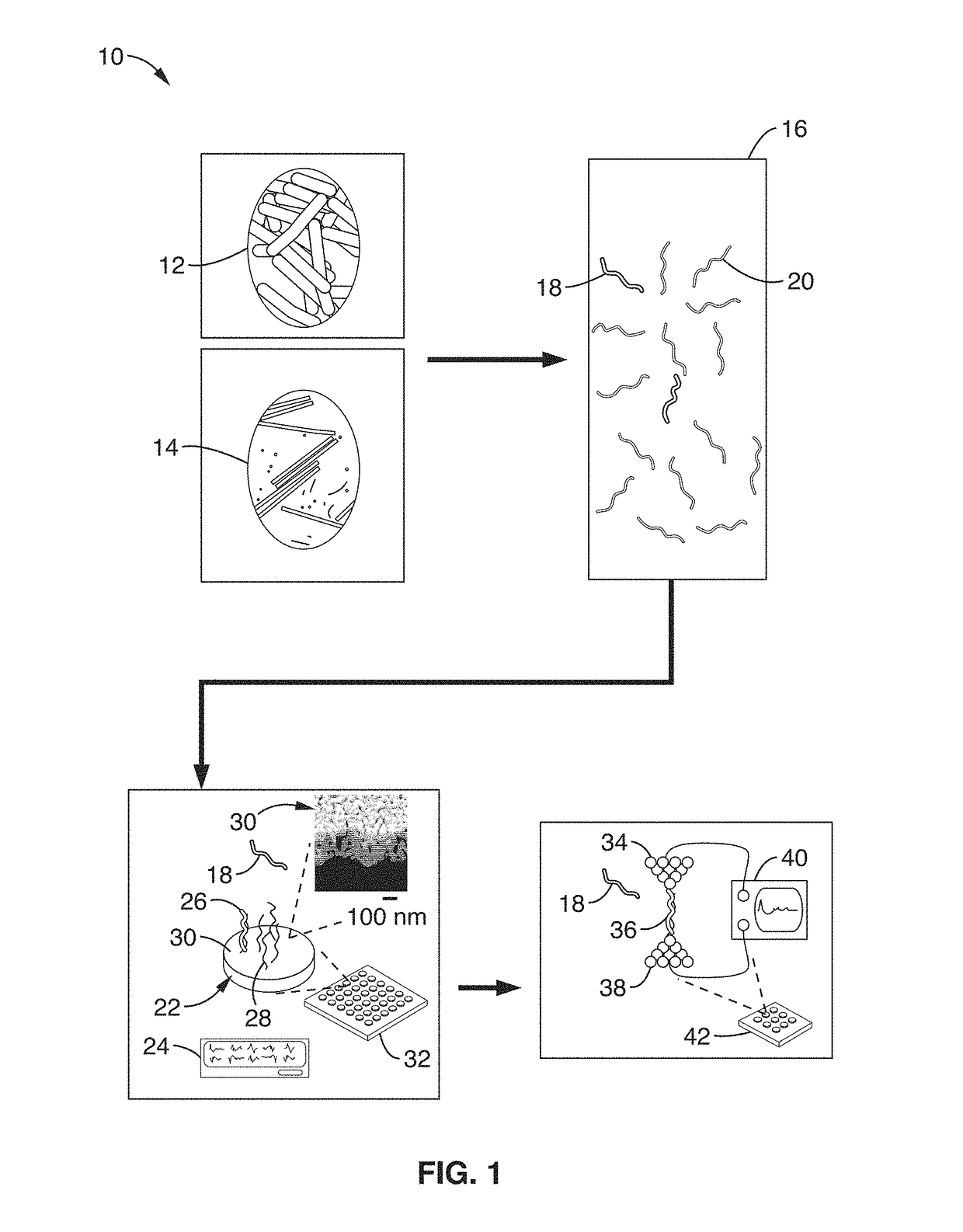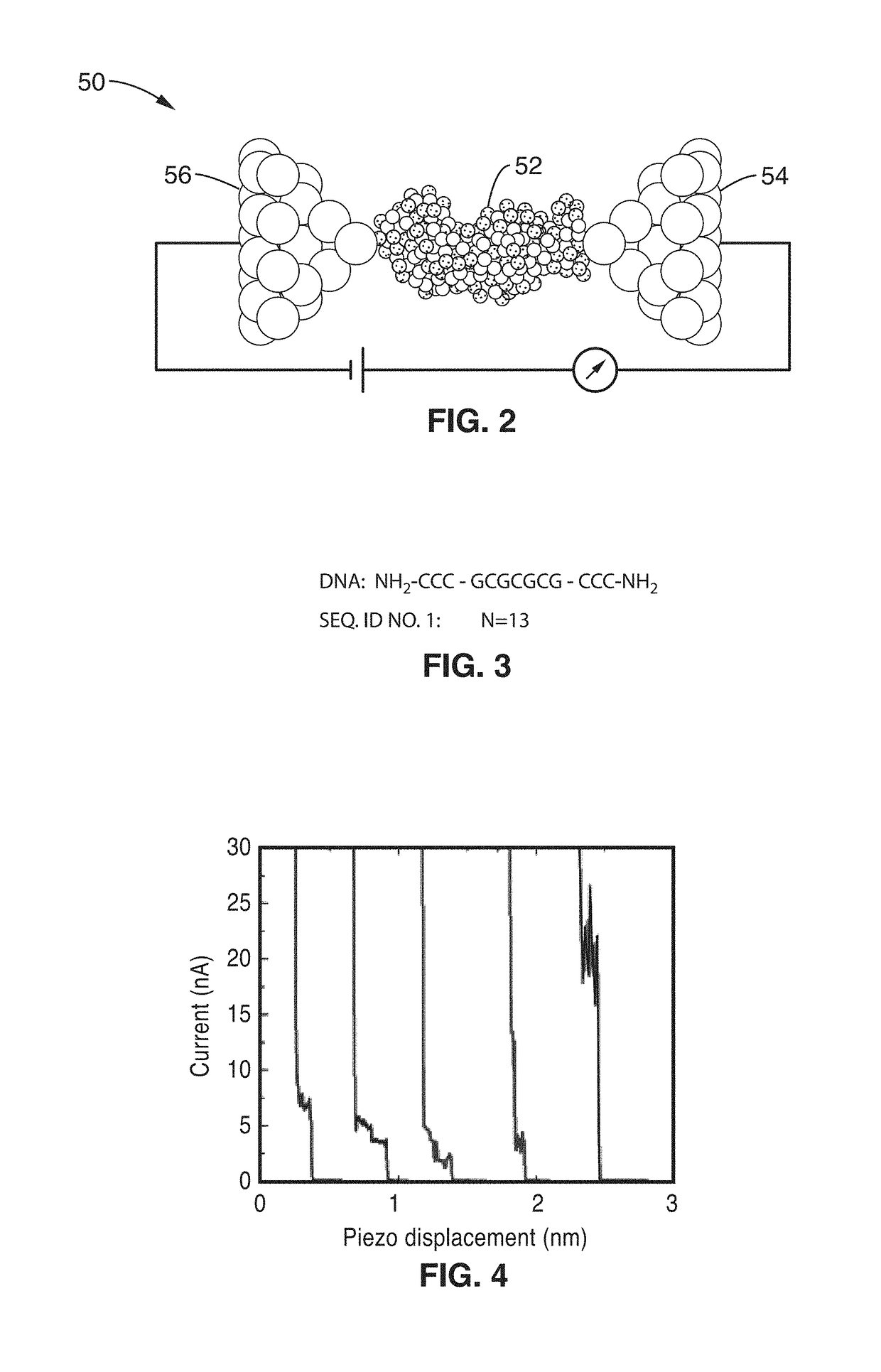RNA-based, amplification-free, organism identification using nano-enabled electronic detection
a technology of electronic detection and nano-enabled detection, applied in the field of system and methods for detecting and identifying rna sequences in biological organisms, can solve the problems of increasing the processing time and cost of detection and identification
- Summary
- Abstract
- Description
- Claims
- Application Information
AI Technical Summary
Benefits of technology
Problems solved by technology
Method used
Image
Examples
example 1
[0045]FIG. 1 shows a schematic diagram of an electrical sensor platform 10 to detect bacteria 12 (i.e. food-borne bacteria) and viruses 14 (i.e. plant viruses) according to an embodiment of the subject invention. After fragmentation 16 of the RNA into target 18 and non-target 20 nucleic acid fragments, the fragments are transported to a stage 22 that rapidly screens for organism / microbe / pathogen groups using redox-based electrochemical detection of hybridization events 26. These hybridization events 26 are detected using densely-packed probe molecules (sequences) 28 bound to nanoporous gold electrode surfaces 30 and a device for measuring electrical current 24, such as a potentiostat. A magnified image of the stage 22 surface with the gold electrode surfaces 30 is shown.
[0046]This electrochemical approach can be scaled into large multiplexed arrays 32 for high-throughput and rapid screening. Thiolated “probe” sequences 28 that are complementary to the RNA target 18 sequences are bou...
example 2
[0052]In order to determine whether unique genetic sequences could be detected with the approach described, an in silico preliminary study was undertaken using the nucleic acid sequences of strains 4, 5, and 6 of grapevine leafroll-associated viruses, which are 13830, 13384 and 13807 nucleotides in length respectively. In silico ribonuclease A-digestion of these sequences, followed by sorting of the residual sequences by length and comparison between strains was carried out. This analysis identified 3, 4 and 9 unique residual fragments of lengths ranging from 15 to 20 nucleotides from strains 4, 5 and 6 respectively. These 16 sequences had an average GC content of 48.5 percent, which shows that hybridization is reasonable.
example 3
[0053]Experimental evidence has been obtained to demonstrate the feasibility of using single-molecule conductance measurements to detect specific RNA sequences and identify a specific strain of microorganism.
[0054]Direct measurement of the electrical conductance of hybrid DNA:RNA molecules was demonstrated in a liquid environment at the single-molecule level by using nanoscale electrodes to directly interrogate the electrical properties of the hybrid molecular junction. Notable differences in the conductance properties of DNA:RNA hybrid sequences were observed, and it has been experimentally shown that the conductance of such hybrid systems is sensitive to the number of base pairs in the stack, which offers the required specificity to the sensor.
[0055]Three DNA probe sequences with lengths of 9, 11, and 13 base pairs were synthesized with amine terminal groups on both the 5′ and 3′ ends. These terminal groups allow direct linkage to atomically sharp gold electrodes. In an aqueous en...
PUM
| Property | Measurement | Unit |
|---|---|---|
| temperature | aaaaa | aaaaa |
| electrochemical current | aaaaa | aaaaa |
| conductance | aaaaa | aaaaa |
Abstract
Description
Claims
Application Information
 Login to View More
Login to View More - R&D
- Intellectual Property
- Life Sciences
- Materials
- Tech Scout
- Unparalleled Data Quality
- Higher Quality Content
- 60% Fewer Hallucinations
Browse by: Latest US Patents, China's latest patents, Technical Efficacy Thesaurus, Application Domain, Technology Topic, Popular Technical Reports.
© 2025 PatSnap. All rights reserved.Legal|Privacy policy|Modern Slavery Act Transparency Statement|Sitemap|About US| Contact US: help@patsnap.com



